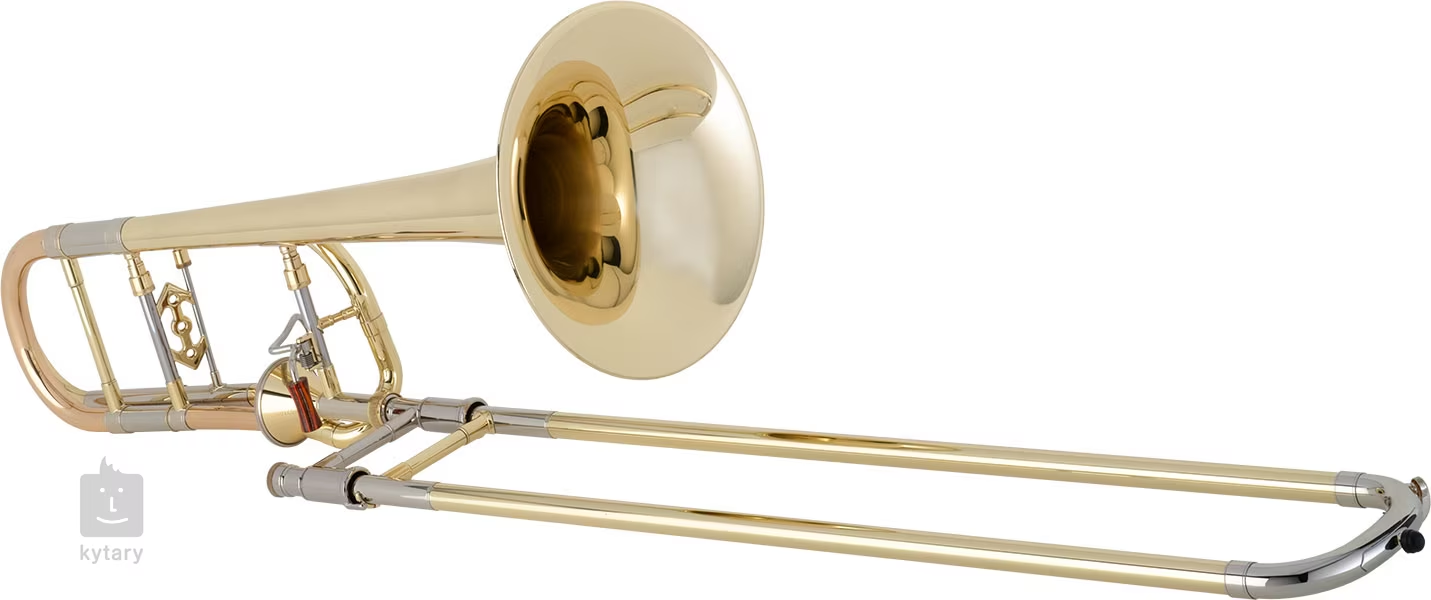
Edwards T-350-HB
This horn is based on the T350-E, but with some important differences. In addition to the patented Harmonic Bridge, hard density cross braces improve the response of horn. The rose neckpipe counters that harder density to achieve a perfectly-balanced tenor trombone.
While developing the T396-AR, we tested the patented Harmonic Bridge on our T350. We found that it worked extremely well with the Thayer valve, but unfortunately, production demands prevented us from adding it to more than one model at the time. After working hard to meet our ever-growing demand, the T350-HB is ready to give tenor trombonists the acoustical tuning that was previously only available on the T396-AR.
The T350-HB is available with 8″ or 8½” bell flares in a variety of wall thicknesses and tempers with either soldered or unsoldered rims. In addition, you may choose from yellow, rose, or red brass with a clear lacquer finish.
Single bore slides in standard weight include three brass leadpipes with further custom leadpipe options available in silver and brass.
Finally, changing tuning slide material and design can have a profound effect on instruments. Edwards has many tuning slide options available on request.
This system will work with any T350 or T350-E tenor trombone. For those of you whose horns have a bell tab, the tab will either need to be removed or filed down. The bell tab and screw are no longer needed with the Harmonic Bridge.
Specs & Features
• Bore Size
.547" or .547"/.562" bore
• Leadpipe
Interchangeable leadpipe system with 3 leadpipes
• Slides
The T-STDN is the standard .547" single bore slide. This slide has a more rounded end crook similar to Conn slides. Quick in response, the T-STDN blows freely in all registers. A very centered tone can be achieved with this slide.
The T-BCN has a bass end crook similar to Bach slides. The squared-off design of this crook allows for a very open low register and a bigger sound overall than the T-STDN slides. This slide is also a .547" bore.
• Tuning Slides
Single Radius tuning slides are the most common. They have one continuous bend from small to large end. They are very free blowing and open in all registers.
Dual Radius tuning slides have two bends. The shape is more square with the two bends making a flattened top. The dual radius provides a quicker response and ease in the upper register, however, the sound is more compact than the single radius tuning slide. All dual radius tuning slides are CF treated to offset the compact nature of this tuning slide.
Both types available in yellow or red brass
• Valves
Axial Flow Valve
Pitched in F
• Harmonic Bridge (US Pat No 8,247,675)
Consumers (and even some manufacturers) often overlook the importance of bracing. It's vitally important for two reasons. First, a solid brace design allows manufacturers to build stress-free instruments. Second, an instrument's playability and response will be exponentially better with braces in the correct nodal positions on the instrument. This means the T350-HB will sing for you.
The T350-HB utilizes the Harmonic Bridge (US Pat No 8,247,675) and Harmonic Pillars (US Pat No 8,247,675).
• Bell Weights
21 Gauge - Heaviest (.028" thick)
22 Gauge (.025" thick)
23 Gauge - Lightest (.022" thick)
• Bell Materials
Yellow Brass (70% Copper / 30% Zinc)
Rose Brass (85% Copper / 15% Zinc)
Red Brass (90% Copper / 10% Zinc)
• Bell Treatments
Soldered
A soldered bell tends to have a very centered sound with a lot of core (fundamental). The articulations are slightly dampened and softer with the solder, while the sound is more direct and compact.
Unsoldered
An unsoldered bell has a very wide sound with more overtones. Articulations are easier with an unsoldered rim. More near feel is apparent with these bells as the sound is wider, which helps give the player more feedback.
Tempered
Tempering occurs when a bell is spun twice on a mandrel which work hardens the bell. This adds brilliance and color to the sound.
Double Buffed
Double buffing thins the bell slightly. It actually creates a thickness in between any two gauges.
Heat Treated
Heat treating is a baking of the entire bell. This softens the metal immensely and creates a very dark sound. This works best on heavier bells as it tends to free them up. Heat treating is not recommended on thinner bells as it makes them more prone to mute dents. The CF treatment has virtually replaced heat treating.
CF Treated
CF treating is a partial heat treating process. This treatment allows the bell to blow more freely and adds color to the sound.
• Finishes
Raw Brass
Lacquer
Silver Plate
Satin Finish
- We offer the best price on the market
- Free shipping on purchases over €299.00
- Extended 3-year warranty
- Goods can be returned within 30 days*
- We pay for shipping when you return goods
- You get a bonus with every purchase
- Wind Instrument Type Tenor Trombone
- Tuning Bb/F
- Bore 13.9 mm
- Bell 216 mm
- Body Brass
- Country of Production USA



















